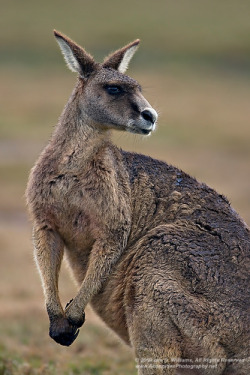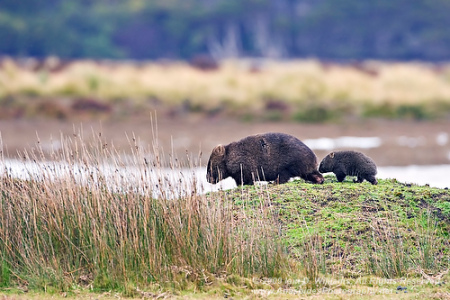Wombats, Kangaroos & Young - Tasmania
 Thursday, September 10, 2009 at 4:03PM
Thursday, September 10, 2009 at 4:03PM
 The last few weeks have brought exceptionally severe weather to the state. High winds, rain and occasional snow have fallen as embedded lows within several; frontal systems cross Tasmania.
The last few weeks have brought exceptionally severe weather to the state. High winds, rain and occasional snow have fallen as embedded lows within several; frontal systems cross Tasmania.
The last few days has a seen a break in the weather and I decided to head 4 hours north to spend two days at a favourite location to photograph wombats and kangaroos. At this time of year the young are still in the pouch and my aim was to attempt to secure images of young wombats and Eastern Grey Kangaroos. Of course pre-visualizing what you want in a photograph and actually achieving that are two different animals.
The weather didn’t hold off as anticipated and rain showers crossed frequently during the two days interspersed with periods of sunshine and cloud cover. Personally I enjoy the rain and have never minded being out in the weather photographing wildlife, however, care must be taken with equipment - Canon claims their 1D series cameras and L series lens are waterproof, but I always take precautions and use rain covers when possible. Further, when furry animals are wet they take on a distinctly different appearance to when they are dry and fluffy-like – this is a look I rather like and find endearing.

The area I was located is quite extensive and wildlife can be observed anywhere along a 7 mile stretch of land, which due to the recent torrential rain was totally water-logged almost resembled an inland sea. Once one site, the first task is to actually discover where the animals are and then “hang about” observing them so they become used to your presence. Only then can you approach close enough to capture images. I’m always careful never to approach too close – no photograph is worth disturbing an animal.
Wildlife Prolific
On this short trip, the wildlife was quite prolific. Black Cockatoos flew overhead making their raucous calls and several wombats grazed along the grassy verge. Two mobs of Eastern Grey Kangaroos were easily spotted and within the group there were several females with young. A number of bird species were seen including the large Mountain Duck and the Red-beaked Black Swan. Located in the bracken fern were two species of wallaby – the Tasmanian Paddymellon and the Bennett’s Wallaby. Both animals are very attractive marsupials with distinct facial markings. They inhabit the bracken fern as the new fern growth is one of their favourite food supplies.
My aim, however, was young animals in the pouch, but during the morning I saw very few with young, and of those I did, the young were safely tucked away from harms way in the rearward opening pouch of the mother. Instead, I was content to spend my hours with a mob of Eastern Greys.
 During the hours I spent amougst the "mob" I observed several aspects of behaviour including: grazing, resting, maternal affection, male aggression, sexual excitement, cough rumination and scratching.
During the hours I spent amougst the "mob" I observed several aspects of behaviour including: grazing, resting, maternal affection, male aggression, sexual excitement, cough rumination and scratching.
At one stage the rain was so heavy, that I stopped photographing and we both looked at each other wondering why we were standing out here in the weather!
I’m always amazed at the speed and agility of kangaroos when they put “their pads to the floor”. Hopping is a very cost effective method of travel and “roos” can travel vast distances in a relatively short  period of time. The photograph lower down was taken when part of the mob decided to move on. The lead kangaroo makes the first move, and the remainder follow. The height these animals were hopping was well in excess of 2.5 meters (10 feet) and the speed was impressive – especially when you take into account they were hopping through and over water roughly 1 foot deep!
period of time. The photograph lower down was taken when part of the mob decided to move on. The lead kangaroo makes the first move, and the remainder follow. The height these animals were hopping was well in excess of 2.5 meters (10 feet) and the speed was impressive – especially when you take into account they were hopping through and over water roughly 1 foot deep!
Mother Wombat & Following Baby
Earlier, I had observed a female wombat and baby and knew there were “holing” up within a burrow in the general location. All one could do was play the waiting game in the rain! My patience was rewarded, albeit briefly when the mother wombat and baby made an all too brief visit from their burrow to graze on the succulent grass. I knew I would have to be fast if I wanted an image; it was obvious this mother was not taking any chances with her young infant. She was cautious and vigilant and once she saw me began making an immediate bee-line to one of her burrows.
As I had pre-visualized the image I wanted, and knew the location of the main burrow, it was a relatively easy deduction to assume the wombat and baby would bee-line along the top of the mound to reach the entrance to the burrow. I was right! For a brief 10 seconds the wombat was silhouetted on top of the mound with baby in tow.




Reader Comments (3)
Nice images. I particularly love the attitude of the joey in the pouch and the baby wombat following mom. Too cute.
Thanks Rebecca. It took a few hours with the mob to get this shot, but persistence pays off sometimes - no "first visitors" luck here ! :)
Excellent post. It makes me realize the energy of words and pictures. I learn a lot, thank you! Wish you make a further progress in the future.